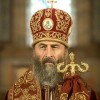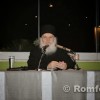Source:http://www.goarch.org/
introduction
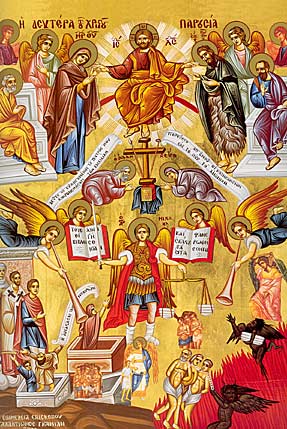
Icon of the The Last Judgement used with permission and provided by: ΕΚΔΟΣΗ
και ΕΠΙΣΚΟΠΟΥ , ΓΑΛΑΚΤΙΩΝΟΣ ΓΚΑΜΙΛΗ ΤΗΛ. 4971 882, ΕΚΤΥΠΟΣΗ Μ. ΤΟΥΜΠΗΣ Α.Ε.
,
The Sunday of the Last Judgment is the third Sunday of a three-week period
prior to the commencement of Great Lent. During this time, the services of the
Church have begun to include hymns from the Triodion, a liturgical book that
contains the services from the Sunday of the Publican and the Pharisee, the
tenth before Pascha (Easter), through Great and Holy Saturday. On this day,
focus is placed on the future judgment of all persons who will stand before the
throne of God when Christ returns in His glory.
biblical story
The commemoration for this Sunday is taken from the parable of our Lord Jesus
Christ concerning his Second Coming and the Last Judgment of all, both the
living and the dead. In Matthew 25:31-46, Christ speaks about what will happen at this
specific point in time when He will “come in His glory, and all the holy angels
with Him” (v. 31).
At His coming, “He will sit on the throne of His glory,” and all of the
nations will be gathered before Him. He will separate them “as a shepherd
divides his sheep from the goats” (v. 32). The sheep will be placed on His right hand, and the
goats on the left. To the sheep, He will say “Come, you blessed of My Father,
inherit the kingdom prepared for you from the foundation of the world” (vv. 33-34)
This kingdom is offered to the sheep because of their compassion and service
to those in need. Jesus says, “…for I was hungry and you gave Me food; I was
thirsty and you gave Me drink; I was a stranger and you took Me in; I was naked
and you clothed Me; I was sick and you visited Me; I was in prison and you came
to Me.”
The sheep, who are the righteous chosen for the kingdom, will ask how this
could be so. They will ask Jesus when was He hungry or thirsty, a stranger,
naked, and in prison. He will answer them by saying, “Assuredly, I say to you,
inasmuch as you did it to the least of these My brethren, you did it to me” (vv. 35-40).
Christ the King, seated on His throne of judgment, will then turn to the
goats on His left and say, “Depart from Me, you cursed, into the everlasting
fire prepared for the devil and his angels” (v. 41). He will condemn them because they did not feed Him
when He was hungry, give Him drink when He was thirsty, take Him in when He was
a stranger, clothe Him when He was naked, visit Him when He was sick or in
prison.
The goats will ask the Lord, “When did we see You hungry or thirsty or a
stranger or naked or sick or in prison, and did not minister to You?” Then He
will answer them saying, “Assuredly, I say to you, inasmuch as you did not do it
to one of the least of these, you did not do it to me” (vv. 42-45).
Jesus concludes His words on the Last Judgment by stating that those on the
left “will go away into everlasting punishment, but the righteous into eternal
life” (v. 46).
On the past two Sundays of this pre-Lenten period, the focus was placed on
God’s patience and limitless compassion, of His readiness to accept every sinner
who returns to Him. On this third Sunday, we are powerfully reminded of a
complementary truth: no one is so patient and so merciful as God, but even He
does not forgive those who do not repent. The God of love is also a God of
righteousness, and when Christ comes again in glory, He will come as our Judge.
Such is the message of Lent to each of us: turn back while there is still time,
repent before the End comes.
This Sunday sets before us the eschatological dimension of Lent: the Great
Fast is a preparation for the Second Coming of the Savior, for the eternal
Passover in the Age to Come, a theme that is also the focus of the first three
days of Holy Week. But the judgment is not only in the future. Here and now,
each day and each hour, in hardening our hearts toward others and in failing to
respond to the opportunities we are given of helping them, we are already
passing judgment on ourselves.
Another theme of this Sunday is that of love. When Christ comes to judge us,
what will be the criterion of His judgment? The parable of the Last Judgment
answers: love—not a mere humanitarian concern for abstract justice and the
anonymous “poor,” but concrete and personal love for the human person—the
specific persons that we encounter each day in our lives.
Christian love is the “possible impossibility” to see Christ in another
person, whoever he or she is, and whom God, in His eternal and mysterious plan,
has decided to introduce into my life, be it only for a few moments, not as an
occasion for a “good deed” or an exercise in philanthropy, but as the beginning
of an eternal companionship in God Himself.
The parable of the Last Judgment is about Christian love. Not all of us are
called to work for “humanity,” yet each one of us has received the gift and the
grace of Christ’s love. We know that all persons ultimately need this personal
love—the recognition in them of their unique soul in which the beauty of the
whole creation is reflected in a unique way. We also know that people are in
prison and are sick and thirsty and hungry because that personal love has been
denied them. And, finally, we know that however narrow and limited the framework
of our personal existence, each one of us has been made responsible for a tiny
part of the Kingdom of God, made responsible by that very gift of Christ’s love.
Thus, on whether or not we have accepted this responsibility, on whether we have
loved or refused to love, shall we be judged.
icon of the feast
The icon of the Sunday of the Last Judgment incorporates all of the elements
of the parable from Matthew 25:31-46. Christ sits on the throne and before him the
Last Judgment takes place. He is extending his hands in blessing upon the
Theotokos on his right, and John the Baptist on his left. Seated on smaller
thrones are the Apostles, represented by Peter and Paul, a depiction of the
words of Christ in Matthew 19:28. (1.)
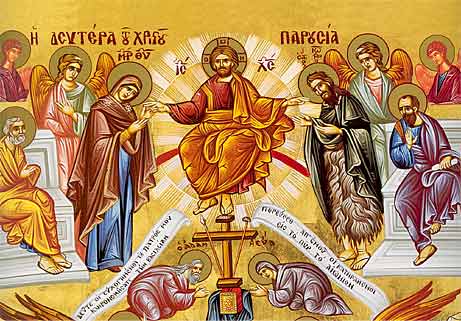
1. Christ is seated on the throne between the Theotokos (left) and Saint
John the Baptist (right). Seated on smaller thrones are the Apostles,
represented here by Saint Peter (left) and Saint Paul
(right).
Proceeding from the throne are the scrolls pronouncing the judgment upon the
sheep and the goats. (2.)The faithful are received with the words that are
written on the scroll to the right of Christ the Judge, “Come, you blessed of My
Father, and inherit the kingdom” (v. 34). The scroll on the left condemns the
unfaithful with the words, “Depart from me you cursed, into the everlasting
fire” (v. 41).
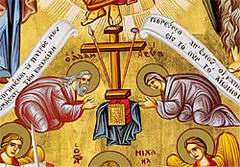
2. The scrolls pronouncing the judgement can be seen at Christ’s feet and
below them, Adam and Eve bow before Christ.
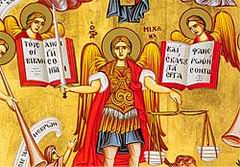
3. Below Adam and Eve is the Archangel Michael surrounded by the books which
contain the works of each person.
Before the throne, the progenitors of the human race, Adam and Eve, bow
before Christ. (2.)In the center of the icon is the Archangel Michael. He is
holding the scales of judgment and is surrounded by the books that contain the
works of each person (Revelation 20:11-13). (3.) Also shown are the angels with
trumpets announcing the return of Christ and signaling the resurrection of the
dead and the commencement of the Last Judgment (I Thessalonians 4:16-17). (4.)
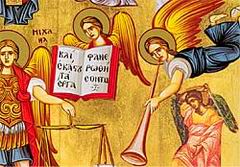
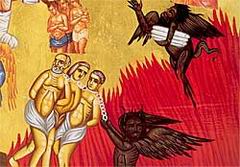
4. To the left and right of the Archangel Michael are angels with
trumpets announcing to the world the return of Jesus Christ, the start of the
Last Judgements, and signaling the resurrection of the
dead.
To the left of the Archangel are both the living and the dead who are
approaching the throne and Christ the judge. Whereas Adam and Eve are
representative of all of humanity, this part of the icon shows that both the
living and the dead will stand before Christ. (5.)
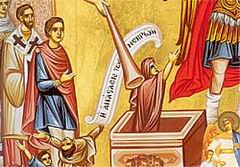
5. Pictured to the bottom-left of the Archangel Michael are the living and
dead coming before the throne of Christ the judge.
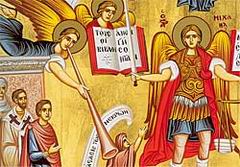
6. To the bottom-right of the Archangel Michael is the eternal fire that has
been prepared for the devil, his demons, and those who are not worthy of
inheriting the Kingdom of God.
At the bottom right of the icon is the everlasting fire prepared for the
devil and the demons, and also for those who are not found worthy to inherit the
Kingdom of God. (6.)
The icon offers a clear image of the theme of judgment with Christ on His
throne, the Archangel with the scales and books, and the anticipation of the
sentence of everlasting punishment for the unrighteous and the reward of eternal
life for the righteous.
orthodox christian commemoration of the sunday of the last Judgement
The Sunday of the Last Judgment is commemorated with the Divine Liturgy of
Saint John Chrysostom, which is preceded by the Matins service. A Great Vespers
is conducted on Saturday evening. The hymns of the Triodion for this day are
added to the usual prayers and hymns of the weekly commemoration of the
Resurrection of Christ. The naming of the Sunday is related to the reading of
the story from the Gospel at the Divine Liturgy.
Scripture readings for the Sunday of the Last Judgment are: At the Orthros
(Matins): The prescribed weekly Gospel reading. At the Divine Liturgy: I Corinthians 8:8-9:2; Matthew 25:31-46.
The Sunday of the Last Judgment is also known as Meatfare Sunday. This is the
last day that meat can be eaten before the Lenten fast. Dairy products are
allowed on each day of this week, even Wednesday and Friday. The next Sunday is
the Sunday of Cheesefare, It is the last day that dairy products can be eaten
prior to the commencement of Great Lent.
On the Saturday before this Sunday, the first of three Saturdays of the Souls
are held. This is a special commemoration on this and the next two Saturdays,
when the Church offers a Divine Liturgy and Memorial Service for the departed
faithful. This is considered a universal commemoration of the dead. It is
closely related to the theme of the Sunday of the Last Judgment since the
services focus on the Second Coming of Christ and the resurrection of the dead.
Through the memorial services, the Church is commending to God all who have
departed and who are now awaiting the Last Judgment.
Hymns of the Feast
Doxastikon of Matins (Tone 1)
Glory to the Father, and to the Son, and to the Holy Spirit; now and ever and
unto ages of ages. Amen.
Let us go before, O brethren, and cleanse ourselves for the Queen of virtues;
for behold she hath come bringing to us fortune of good deeds, quenching the
uprisings of passion and reconciling the wicked to the Master. Let us welcome
her, therefore, shouting to Christ God, O thou who arose from the dead, keep us
uncondemned, who glorify Thee, O Thou who alone art sinless. Listen >>
Kontakion (Tone One)
When Thou comest, O God, upon the earth with glory, the whole world will
tremble. The river of fire will bring men before Thy judgment seat, the books
will be opened and the secrets disclosed. Then deliver me from the unquenchable
fire, and count me worthy to stand on Thy right hand, Judge most righteous.
The Lenten Triodion. translated by Mother Mary and Kallistos Ware
(South Canaan, PA: St. Tikhon’s Seminary Press, 1994), pp. 45-46, 150-167.
Schmemann, Alexander. Great Lent: Journey to Pascha (Crestwood, New York: St.
Vladimir’s Seminary Press, 1969), pp. 23-26.
Barrois, Georges. Scripture Readings in Orthodox Worship (Crestwood, New
York: St. Vladimir’s Seminary Press, 1977), pp. 26-29.
Farley, Donna. Seasons of Grace: Reflections on the Orthodox Church Year (Ben
Lomond, CA: Conciliar Press, 2002), pp. 84-86.













